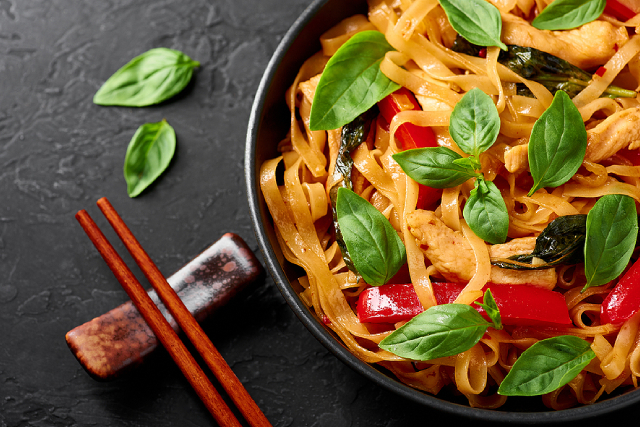
Embarking on a culinary adventure through Southeast Asia promises a symphony of flavours, aromas, and textures that tantalise the taste buds and leave a lasting impression. From aromatic curries to spicy street food delights, the region boasts a rich tapestry of culinary traditions influenced by diverse cultures and centuries-old culinary heritage.
In this gastronomic journey, we explore some of the top foods that every foodie must try when traversing the vibrant landscapes of Southeast Asia.
1. Pad Thai (Thailand)
No culinary exploration of Southeast Asia is complete without indulging in the iconic Pad Thai.
This quintessential Thai street food dish combines stir-fried rice noodles with a harmonious blend of sweet, sour, and savoury flavours. Typically featuring ingredients such as shrimp, tofu, eggs, bean sprouts, and crushed peanuts, Pad Thai exemplifies the perfect balance of textures and tastes. Served with a wedge of lime and a sprinkle of chilli flakes, it’s a culinary masterpiece that captures the essence of Thai cuisine.
2. Pho (Vietnam)
Heralded as Vietnam’s national dish, Pho is a comforting bowl of rice noodles immersed in a fragrant broth infused with herbs and spices. Whether enjoyed for breakfast, lunch, or dinner, Pho tantalises the senses with its aromatic allure and depth of flavour.
Traditionally made with either beef (Pho bo) or chicken (Pho ga), this iconic dish is adorned with fresh herbs, lime wedges, chilli, and bean sprouts, allowing diners to customise each spoonful to their liking. A steaming bowl of Pho offers a glimpse into Vietnam’s culinary heritage and its enduring love affair with soul-warming soups.
3. Laksa (Malaysia and Singapore)
Laksa stands as a testament to the culinary fusion that defines Malaysian and Singaporean cuisine. This hearty noodle soup combines influences from Malay, Chinese, and Indian culinary traditions to create a symphony of flavours that captivate the palate.
Featuring a rich and creamy coconut milk broth infused with aromatic spices, Laksa is often embellished with ingredients such as shrimp, chicken, tofu puffs, fish cakes, and fresh herbs. The interplay of creamy, spicy, and tangy notes makes Laksa a perennial favourite among locals and visitors alike.
4. Tom Yum Goong (Thailand)
Renowned for its bold and vibrant flavours, Tom Yum Goong is a quintessential Thai soup that commands attention with its fiery demeanour. Combining elements of sweet, sour, and spicy, this aromatic broth is infused with lemongrass, galangal, kaffir lime leaves, chilli, and fish sauce, culminating in a taste sensation that lingers long after the last spoonful. The addition of plump shrimp (Goong) adds a delightful sweetness to the dish, while mushrooms and tomatoes contribute to its complexity.
Tom Yum Goong exemplifies the bold and dynamic flavours that characterise Thai cuisine.
5. Nasi Goreng (Indonesia)
As Indonesia’s national dish, Nasi Goreng is a beloved culinary staple that reflects the country’s diverse cultural influences. Translating to “fried rice” in Bahasa Indonesia, this flavorful dish is a medley of fragrant rice stir-fried with a symphony of spices, shrimp paste, sweet soy sauce, and a variety of proteins such as chicken, shrimp, or eggs. Served with a garnish of crispy shallots and accompanied by condiments such as pickled vegetables and spicy sambal, Nasi Goreng embodies the essence of Indonesian comfort food.
6. Adobo (Philippines)
Often hailed as the national dish of the Philippines, Adobo is a savoury stew made with meat (usually chicken or pork) marinated in soy sauce, vinegar, garlic, bay leaves, and black peppercorns, resulting in a tender and flavourful dish that pairs perfectly with steamed rice.
7. Char Kway Teow (Malaysia and Singapore)
A beloved street food classic in Malaysia and Singapore, Char Kway Teow is a stir-fried noodle dish that embodies the essence of Southeast Asian comfort food. Featuring flat rice noodles stir-fried with a medley of ingredients such as shrimp, Chinese sausage, eggs, bean sprouts, and chives, Char Kway Teow is elevated by the smoky aroma imparted by the wok hei (breath of the wok). A combination of soy sauce, chilli paste, and sometimes a squeeze of lime adds depth and complexity to this iconic dish, making it a fan favourite among food enthusiasts.
Conclusion
Embarking on a culinary journey through Southeast Asia is an exhilarating experience that promises a sensory feast for the palate. From the fragrant curries of Thailand to the comforting noodle soups of Vietnam and the bold flavours of Malaysia and Indonesia, the region’s culinary landscape is as diverse as it is delicious. Whether indulging in street food delights or savouring traditional dishes in local eateries, every bite offers a glimpse into the rich tapestry of flavours, aromas, and textures that define Southeast Asian cuisine.
Though it is best to take precautions and keep yourself safe when eating overseas, it is always best to prepare for the worst. With EMA Global, you can travel with peace of mind. Founded in 1991, we specialise in providing world-class medical evaluation and air ambulance in Singapore. Reach out to us for more information.

